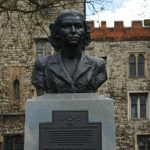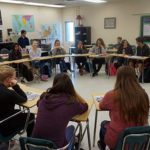
By Alexis Walker
As seen through local, national, and international events of late, understanding government responsibilities has become more important than ever. In our courses as History and Social Studies teachers we strive to support the growth of our students in order for them to successfully navigate the world and engage actively and appropriately through all mediums. CBC reporter Haydn Watters visited my Civics classroom at Brooklin H.S. to see what my students were learning about on the topic of the different responsibilities, and what their thoughts were on government engagement during the pandemic. 8 of my students were brave enough to share, and what they had to say impressed me immensely. Much of the great content did not make the short 5 minute spot, including reference to fantastic resources currently out there to support Civics teachers, but this small glimpse serves as a reminder that what we do everyday with our students is essential in supporting healthy understandings of what government is, and why the common good is so important.
Listen here.
Alexis Walker is a Canadian World Studies teacher in the Durham area. She has been teaching Civics since 2007 and asks for it every year as she recognizes the importance civic engagement promotes within our society. She is a part of the Williams Treaty and thanks the Anishinabek for taking care of the land and for the teachings they share with us every day.


